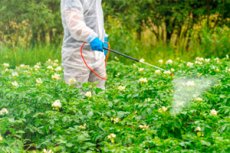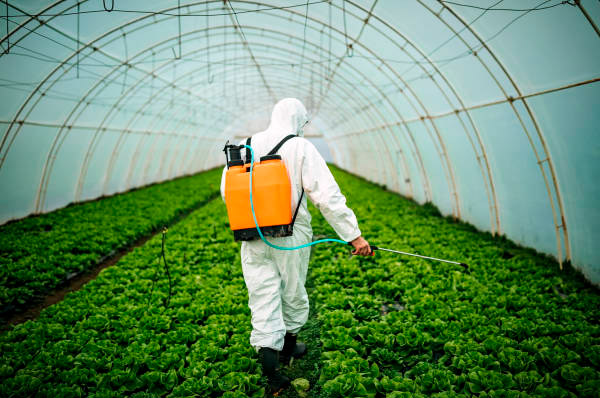Insecticides: classification, examples, and their use
Last reviewed: 11.03.2025

Insecticides are chemical or biological substances designed to destroy insect pests, control their population, and prevent the damage they can cause to plants and farms. They play a crucial role in agriculture, horticulture, and even in domestic settings, helping to protect plants from various insects such as aphids, flies, cockroaches, mosquitoes, and others.
Insecticides can be classified according to various criteria, such as mechanism of action, chemical structure, method of application, and area of use. Let's look at each classification in more detail.
Classification of insecticides
By mechanism of action
Insecticides can affect insects in different ways, from direct contact to inhalation or through the digestive system.
- Contact insecticides: these insecticides act through the skin of insects. They penetrate the body through the epidermis and disrupt the nervous system, leading to the death of the insect. Examples of contact insecticides include pyrethroids (permethrin, deltamethrin). They block nerve impulse transmission, causing paralysis and death of the insect.
- Stomach insecticides: these substances act through the insect's digestive tract. They enter the body through the mouth when insects eat leaves, stems, or other plant parts containing the insecticide. Such substances are often used against insects that feed on plants. Examples include organophosphates and carbamates, such as malathion and carbofos. They block enzymes that are necessary for normal functioning of the insect's nervous system.
- Inhalant insecticides: these insecticides act when the insect inhales the substance. They cause poisoning through the respiratory system, disrupting the gas exchange processes and leading to death. Examples are fumigants used for treating indoor spaces against insects like flies, cockroaches, and others.
- Systemic insecticides: they penetrate the plant tissues and begin acting from within. These substances effectively protect plants from insects that feed on plant juices, such as aphids, whiteflies, and others. Examples of systemic insecticides include imidacloprid, thiamethoxam. They penetrate the plant tissues and spread throughout, making it toxic to insects that consume the leaves or other parts of the plant.
By chemical composition
Insecticides can also be classified according to their chemical structure. Main groups:
- Chlorinated insecticides: these substances contain chlorine and were among the first types of insecticides. They have a long-lasting effect but can accumulate in the body and contaminate the environment. Examples include ddt, aldrin, chlordane. These insecticides suppress the insect's nervous system but have high toxicity and can negatively affect human and animal health.
- Organophosphate insecticides: this group of insecticides affects enzymes necessary for the normal functioning of the insect's nervous system. Examples include malathion, phosphamide. These substances have lower toxicity to humans than chlorinated insecticides but can still be harmful to the ecosystem if used improperly.
- Pyrethroids: these are synthetic insecticides that are structurally similar to natural pyrethrins derived from chrysanthemums. They act on the insect's nervous system, causing paralysis. Examples include permethrin, deltamethrin. These substances are used both in households and in agriculture to protect plants.
- Neonicotinoids: these are synthetic analogs of nicotine that act on the insect's nervous system. They block nerve receptors, causing paralysis and death. Examples include imidacloprid, acetamiprid. These substances act quickly, but due to their toxicity to bees and other beneficial insects, their use raises environmental concerns.
- Biological insecticides: these preparations contain active substances of natural origin, such as bacteria (e.g., bacillus thuringiensis), fungi (metarhizium), or viruses that infect insects. These insecticides are safe for humans and animals but effective against certain pests.

By area of application
Insecticides can be used in various fields, including agriculture, horticulture, and domestic environments.
- Agricultural insecticides: these are used to protect crops from insect pests such as aphids, beetles, flies, and others. Examples include carbophos, gomel, actellik.
- Forest insecticides: these are used to protect forests from insects such as bark beetles that can cause serious damage to forests. Examples include forsight, rogor.
- Household insecticides: these are used indoors to fight pests like cockroaches, flies, mosquitoes, and others. Examples include raid, raptor, gels, and aerosols for cockroaches.
- Medical insecticides: these are used to combat insect vectors of diseases, such as malaria-carrying mosquitoes. Example: dichlorvos.
By method of action
- Fumigants: these insecticides act through the air, spreading inside a room or outdoors. They kill insects that inhale toxic fumes. Examples include sulfur gas, sodium salts.
- Insecticide mixtures: these products contain several active components, each acting on different stages of the insect's life cycle. They help combat a wide range of pests. Example: aktara.
Examples of insecticides
- Imidacloprid (neonicotinoid): this is a systemic insecticide that penetrates plant tissues and protects them from insect pests such as aphids and whiteflies. It is actively used to protect crops such as potatoes, tomatoes, and other vegetables.
- Deltamethrin (pyrethroid): a contact insecticide used to combat flies, cockroaches, and other pests in homes, as well as to protect plants in greenhouses and gardens.
- Malathion (organophosphate insecticide): widely used in agriculture to combat various pests such as mosquitoes, flies, and aphids. It is also used for treating fruits and vegetables.
- Bacillus thuringiensis (biological insecticide): a safe insecticide for humans and animals that is used to fight larvae of insects such as cabbage worms and other pests.
- Permethrin (pyrethroid): a contact insecticide used for combating domestic pests such as ants, cockroaches, and others, as well as for protecting plants from insects in the garden.
- Gomel (chlorinated insecticide): used in agriculture to fight pests like whiteflies, beetles, and others. It has a long-lasting effect and high toxicity for insects.
- Actellik (pyrethroid): used in greenhouses and horticulture to control aphids, mites, and other pests. It is effective against spider mites and other small insects.
- Raptor (pyrethroid): widely used in homes for killing cockroaches, ants, flies, and other pests.
- Phosphamide (organophosphate insecticide): used to control pests on vegetables and fruit crops. Effective against larvae and adult insects.
- Permethrin (pyrethroid): used to combat parasites such as lice, fleas, and also for protection against mosquitoes and other pests.
Conclusion
Insecticides play an important role in protecting agricultural crops and domestic plants from pests. The choice of insecticide depends on the type of pest, the area of use, and the environmental risks involved. Modern insecticides offer a wide range of possibilities for effective pest control, from contact agents to biological solutions.
